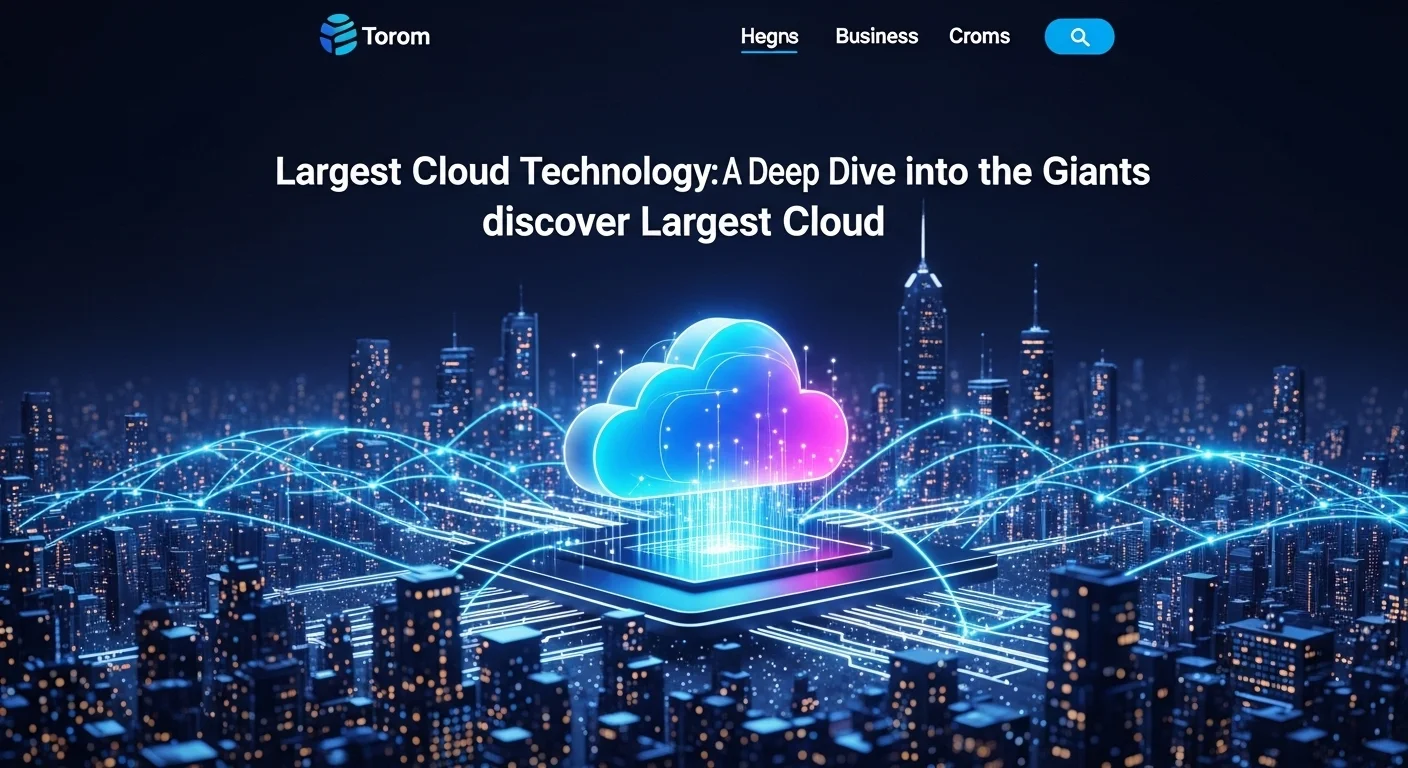Cloud Giants: An Insider's Guide to AWS, Azure, and Google Cloud

Executive Summary
For years, I've watched companies wrestle with a huge question: which cloud provider is right for them? The 'cloud' isn't just one thing; it's a battleground dominated by giants like Amazon Web Services (AWS), Microsoft Azure, and Google Cloud (GCP). In this article, I'm going to pull back the curtain and show you what makes these providers tick. We'll explore their strengths, how they're fueling everything from AI to your favorite apps, and why picking the right one is one of the most critical decisions your business will make. Let's dive in.
Table of Contents
Table of Contents
- What is the Cloud and Why Does It Matter?
- A Complete Guide to the Cloud Giants
- Tips for Mastering the Cloud
What is the Cloud and Why Does It Matter?
When we talk about the 'cloud,' we're really talking about a fundamental shift in how technology works. I remember the days when a company needed a new server. It meant weeks of planning, purchasing expensive hardware, and finding space in a cold, noisy server room. The cloud changed all of that. The 'largest cloud' simply refers to the handful of massive companies that own and operate the global data centers that now power much of the internet. Think of them like a utility. Instead of building your own power plant, you just plug into the grid. These providers—the big players—let you rent computing power, storage, and a whole toolbox of advanced software over the internet on a pay-as-you-go basis.
This is a game-changer. It has leveled the playing field, allowing a startup in a garage to access the same world-class infrastructure as a Fortune 500 company. Every time you stream a movie, use a mobile app, or see a personalized ad, you're interacting with an application running on one of these massive cloud platforms. The top contenders in this space are Amazon Web Services (AWS), Microsoft Azure, and Google Cloud Platform (GCP). They've built a lead that's tough to challenge, creating a powerful ecosystem that drives digital innovation. Their global network of data centers means your services can be fast and reliable for users anywhere in the world, a feat that's practically impossible for a single company to achieve on its own. The intense competition between them is fantastic for us, the users, as it means they are constantly innovating, improving performance, and making prices more competitive.
The impact of the cloud giants is felt everywhere. In Artificial Intelligence (AI), for example, training a machine learning model requires an incredible amount of processing power. Instead of buying millions of dollars worth of specialized hardware, developers can now rent it from a cloud provider for just a few hours. This has unlocked incredible advancements in AI. The same goes for 'Big Data.' Companies can now store and analyze colossal datasets on the cloud to uncover business insights that were previously hidden. And the Internet of Things (IoT), with its billions of connected devices, would be impossible without the cloud as a central hub to collect and process all that data. The cloud has truly become the backbone of 21st-century technology. The reliability and sheer scale of services offered by these market leaders empower the creation of the software that defines our digital world. Without this foundation, the pace of innovation we see today would grind to a halt.
From a business standpoint, the benefits are just as transformative. The most obvious is cost. Shifting from buying expensive hardware (a capital expense) to renting services (an operational expense) frees up cash and reduces upfront risk. It also gives you access to economies of scale you could never achieve on your own. But in my experience, the biggest win is agility. In the old days, getting a new server took weeks. Now, I can spin up a powerful virtual machine in minutes. This speed allows businesses to experiment, innovate, and react to market changes faster than ever before. They can scale resources up to handle a sudden surge in traffic for a Black Friday sale, and then scale back down to save money, all automatically. This elasticity is a core promise of the cloud.
Furthermore, security is a huge concern where the top providers often have an edge. They invest billions in securing their infrastructure, employing armies of the world's best security experts. For most companies, especially smaller ones, the level of security and compliance offered by a major cloud provider is far beyond what they could ever build themselves. They handle certifications for industries like finance and healthcare, which can be a massive headache to manage on your own. When you combine the cost savings, speed, scalability, and security, it's clear why moving to the cloud is no longer a question of 'if' but 'when' and 'who with.' Choosing the right cloud partner is a strategic decision that can shape a company's future, making this a crucial topic for any modern leader.

A Complete Guide to the Cloud Giants
Choosing a cloud provider feels a bit like picking a team to join. Each of the big three has its own culture, strengths, and loyal fanbase. Let's break them down. The long-reigning champion is Amazon Web Services (AWS). They kicked off the public cloud revolution back in 2006 and had a massive head start. In my experience, this maturity shows. AWS has the most extensive and feature-rich portfolio of services, covering nearly any use case you can imagine. From their foundational compute (EC2) and storage (S3) services to cutting-edge AI and IoT tools, they have it all. A huge number of startups and enterprises built their businesses on AWS, so there's a massive community, tons of documentation, and a deep talent pool to hire from. For many, it's the safe, default choice and the benchmark for the entire industry.
The fastest-rising challenger is Microsoft Azure. Microsoft played its cards brilliantly, leveraging its decades-long dominance in the enterprise software world. For the millions of businesses already running on Windows Server, Office 365, and other Microsoft products, Azure feels like a natural extension. Its key superpower is hybrid cloud. Tools like Azure Arc allow companies to manage their own private servers alongside their public cloud resources from a single dashboard. This is a huge selling point for large, established organizations that aren't ready to go 'all-in' on the public cloud just yet. This enterprise focus has helped Azure grow incredibly fast, making it a powerful number two and proving it can win over the world's biggest companies.
Then we have Google Cloud Platform (GCP). As a later entrant, Google focused on what it does best: data, networking, and containers. GCP was essentially built on the same technology that powers Google Search and YouTube, and it shows. It's a powerhouse in data analytics and machine learning, with standout products like BigQuery. In my opinion, its handling of Kubernetes (a technology for managing modern applications, which Google originally invented) is second to none. It has a reputation for being developer-friendly and technologically advanced. While it's third in market share, it's a leader in these high-growth areas and is often the top choice for tech-forward companies building data-intensive applications. Together, AWS, Azure, and GCP are the titans of the cloud, and any serious evaluation needs to look at what each of them brings to the table.
So, how do you choose? There's no single 'best' answer; it's all about finding the right fit for you. The first thing I always ask a client is, 'What does your current tech stack and team look like?' If your team is full of Microsoft experts, Azure will have a much gentler learning curve. If you're a startup building a cutting-edge app with Kubernetes, GCP might be a better fit. The workload itself is also key. A massive data analytics project might point you to GCP's BigQuery, while a standard e-commerce site could run perfectly well on any of the three. Cost is a huge factor, but it's tricky. The pricing models are famously complex. You have to use their calculators and really dig in to understand what your monthly bill will look like. Don't just look at the sticker price; consider the total cost, including migration, training, and ongoing management.
Beyond the technical specs and dollars, think about the ecosystem. How good is the support? What does the marketplace of third-party tools look like? How easy is it to hire developers with experience on that platform? These factors can make or break your cloud journey. My advice is always to start small. Run a proof-of-concept project on one or two platforms to see how they perform with your actual workload. Some organizations even choose a multi-cloud strategy, cherry-picking the best services from different providers. This is more complex to manage, but it offers the most flexibility and helps avoid being locked into a single vendor. This strategic decision is a long-term partnership, so it pays to do your homework and choose wisely.

Tips and Strategies for Mastering the Cloud
Just moving to the cloud isn't enough. To truly get the most out of it, you need to adopt a new way of thinking. Here are some strategies I've seen work time and time again. First and foremost, you have to get a handle on your costs, a practice often called 'FinOps.' The pay-as-you-go model is great, but it can lead to nasty surprises if you're not paying attention. The most common mistake I see is over-provisioning. Continuously monitor your resource usage and 'right-size' them to match the actual demand. Also, get smart about pricing. For steady workloads, use Reserved Instances or Savings Plans to get huge discounts over on-demand prices. For non-critical tasks, Spot Instances can save you up to 90%, but be prepared for them to be interrupted. A solid tagging strategy is also non-negotiable. Tagging every resource with its owner or project lets you see exactly where your money is going.
When it comes to security, remember this: it's a shared responsibility. The cloud provider secures the underlying infrastructure, but you are responsible for securing everything you put on it. The foundation of good cloud security is Identity and Access Management (IAM). Always follow the principle of 'least privilege,' giving users and services only the bare minimum permissions they need to do their job. Always enable Multi-Factor Authentication (MFA), especially for admin accounts. It's one of the simplest and most effective security measures you can take. Next, protect your data. Encrypt sensitive data both in transit (as it moves across the network) and at rest (when it's stored). The major providers make this easy, so there's no excuse not to do it. Regularly scan for vulnerabilities and keep your systems patched. Think of it as basic hygiene for your cloud environment.
Performance is all about building responsive and reliable applications. One of the most powerful cloud features is auto-scaling. Set it up to automatically add or remove servers based on traffic. This ensures your app can handle sudden spikes without crashing and saves you money during quiet periods. Use a load balancer to distribute traffic across your instances for better stability. If you have users around the world, a Content Delivery Network (CDN) is a must. A CDN stores copies of your content in locations close to your users, drastically reducing load times. Finally, think about geography. Deploying your application in a cloud region that's physically closer to the majority of your users can significantly improve their experience. These are fundamental strategies for building professional-grade applications on any major cloud platform.
Lastly, don't stand still. The cloud is constantly evolving. Keep an eye on emerging trends like multi-cloud and hybrid cloud, which offer more flexibility and resilience. Explore serverless computing with services like AWS Lambda or Azure Functions. This approach lets you run code without thinking about servers at all, which can simplify development and operations immensely. And tap into the incredible AI and Machine Learning services that are now integrated into these platforms. They are making it easier than ever to build intelligent applications. My final piece of advice is to foster a culture of continuous learning. The cloud moves fast, and the more you learn, the more value you can unlock. By combining these sound strategies with a forward-thinking mindset, you can ensure your journey to the cloud is not just successful, but truly transformative.
Expert Reviews & Testimonials
Sarah Johnson, Business Owner ⭐⭐⭐
The information about the big cloud providers is good, but as a business owner, I'd have loved to see more real-world case studies.
Mike Chen, IT Consultant ⭐⭐⭐⭐
A solid overview of the cloud landscape. It helped clarify the differences between the major players, though a few technical points could be simplified further.
Emma Davis, Tech Expert ⭐⭐⭐⭐⭐
Fantastic article! Very thorough and insightful look at the cloud giants. It was incredibly helpful for my specialization, and I found it easy to follow.



